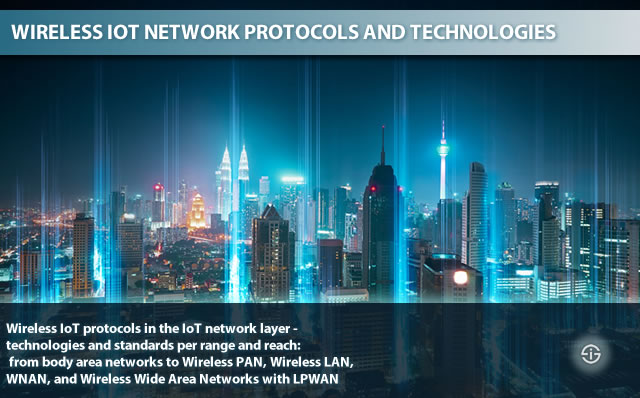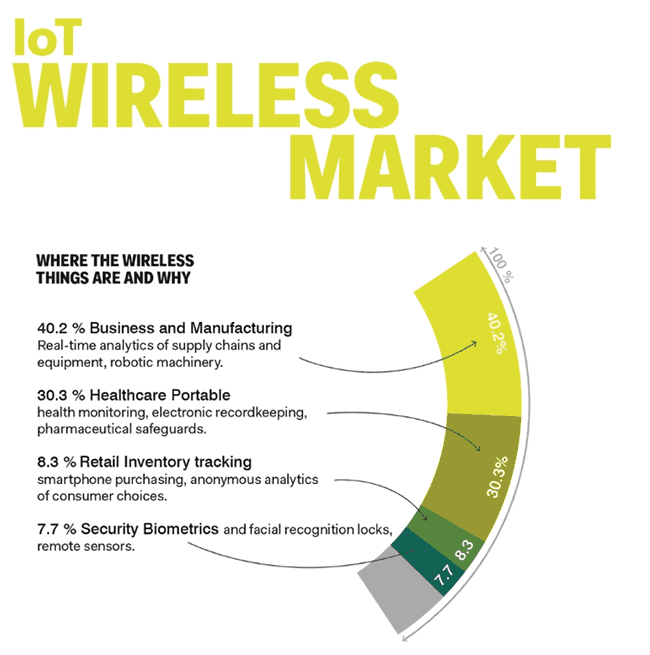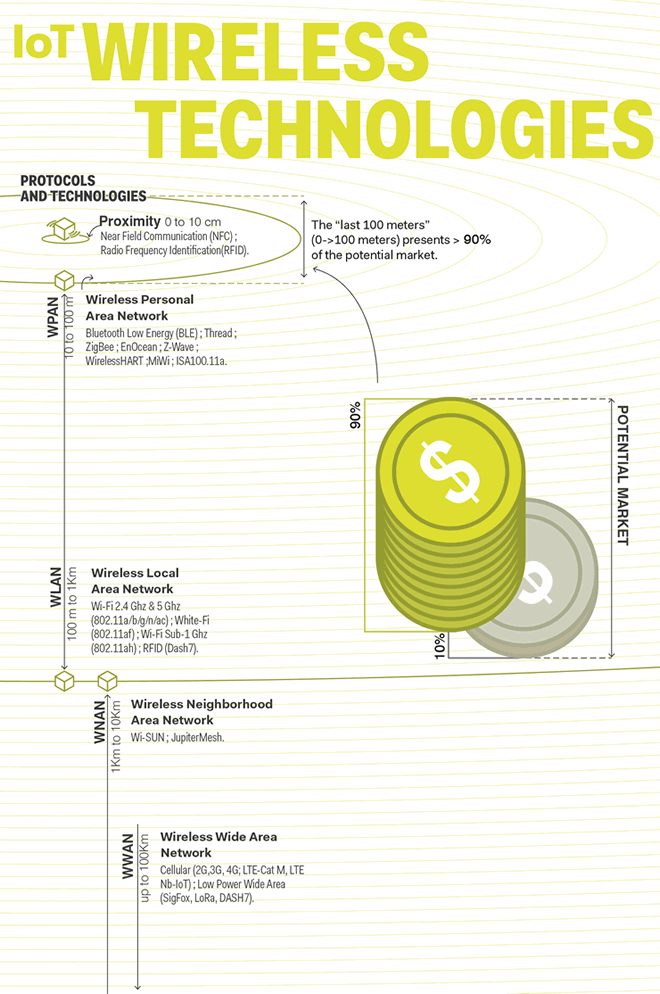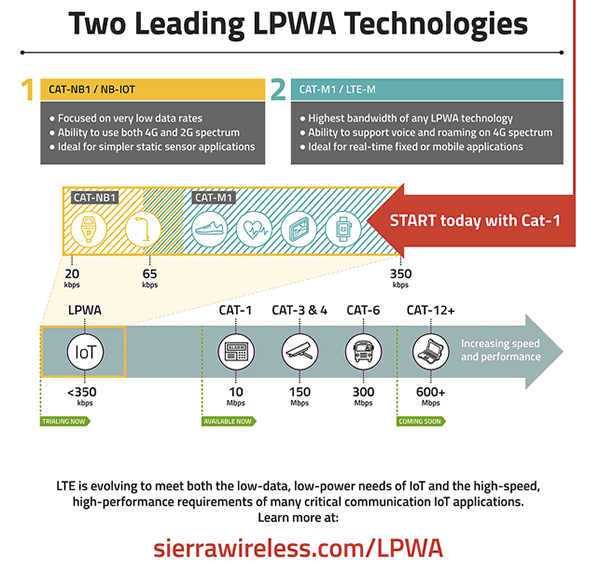Wireless IoT protocols, standards, solutions and technologies for connectivity and data communications come in many flavors for many potential IoT use cases. An overview of wireless IoT protocols and technologies (with some criteria to consider when making choices).
In our guide to IoT we looked at IoT connectivity and IoT network technologies from various angles. One was the division of IoT connectivity solutions in five types of networks, namely PAN, LAN, WAN, MAN and NAN, as is often done (with LPWAN being something else in that classification).
Wireless networks enable far more flexibility than wired networks (IoT book ‘Digitize or Die’ by Nicolas Windpassinger)
These are traditional forms of networks as we know them from the network world whereby the ‘AN’ in each of them stands for Area Network and the letter before the “AN” describes the type of area: Personal, Local, Wide, Metropolitan and Neighbourhood. It’s maybe not the best way ever to look at the various types of IoT connectivity solutions but relevant to look at wireless communication and connectivity protocols and technologies for the Internet of Things. And wireless is the scope of this post. Wireless IoT connections and thus the use of wireless IoT protocols are on the rise, also in the Industrial IoT (IIoT) and Industry 4.0.
There are slightly alternative ways to look at IoT wireless protocols and classify the various types of wireless technologies within each category. And that is precisely what we do in this overview: summarize the IoT wireless technologies in a comprehensive and visual way, with the help of an infographic from IoT book ‘Digitize or Die’, written for digital transformation leaders, as author Nicolas Windpassinger puts it.

The complexity of IoT connectivity and wireless IoT protocols – use cases first
Before doing so, let’s go back to the mentioned classification of PAN, LAN, WAN, MAN and NAN to show how de facto various IoT wireless protocols and IoT connectivity solutions overall are combined and to introduce the classification by Nicolas Windpassinger which uses some of the mentioned terms for his classification and then elaborates on the various IoT wireless IoT technologies within each ‘type’.
We’re not going to explain what personal area networks, local area networks and so forth are. Again, these terms exist since the early days of computer networks so in case they don’t ring a bell, you should find ample information on them. Let’s look at practice and at the variety of connectivity solutions, including IoT wireless technologies, instead and show why no single technology can only be used for one purpose alone.
As an example of where a Personal Area Network would fit in, think about the typically close range and wireless connectivity solutions for consumer IoT applications, from personal healthcare trackers (very close) to the smart home (a bit less close). PAN IoT protocols such as Zigbee (Pro) are also used in non-consumer contexts as well, however: we gave an example of an IoT case whereby Zigbee, built on the 802.15.4 standard, is used as a wireless IoT protocol in an urban air quality control case, whereby it sends data, which are captured via several special sensors, to a sensor hub in a vehicle. Via another wireless technology (in this case 3G) the information is sent to a cloud application.
This simple IoT smart city application shows how de facto in IoT solutions in practice several IoT connectivity solutions are used. Imagine how it is in more complex situations and IoT examples.

Several wireless IoT protocols in the IoT network layer in evolution and the dimension of distance
As we covered before there are quite some IoT network technologies. We’ve touched upon several in the mentioned Internet of Things guide and focused on a few wireless IoT technologies in our LPWA wireless network guide: LoRa and LoRaWAN, Weightless SIG, Sigfox, Ingenu, cellular LPWAN technologies such as NB-IoT and LTE-M, the list goes on.
Add to that new IoT connectivity solutions (5G, new forms of Bluetooth which are specifically designed for IoT applications, new forms of Wi-Fi which are introduced for IoT etc., more below) and the picture becomes pretty complex for many, even in this space of wireless IoT protocols and technologies alone (and there are many we haven’t mentioned).
Which IoT connectivity solution fits best depends on various parameters such as the distance. In our previously mentioned example Zigbee was ideal for what it had to do: cover a short distance within the perimeter of a driving vehicle. So, even if Zigbee is often presented in a context of smart home automation this doesn’t mean it can’t be used (and de facto is used) in business and even industrial IoT implementations.
In his ‘Digitize or Die’ IoT book, Nicolas Windpassinger who is responsible for the global partner program of Schneider Electric, called EcoXpert, provides a great overview of the various wireless IoT technologies from, among others, this perspective of distance as you can see in the infographic below.
The ‘last 100 meters’ represents 90 percent of the potential market in IoT wireless technologies
By the way, just as we and many analysts do, Nicolas believes that wireless networks are a key component in the IoT network layer and that software will become increasingly important in this IoT network layer. In the Industrial IoT and Industry 4.0 the majority of connections is fixed line but here as well wireless connections increase as explained in our article on the evolutions in IIoT communication and connectivity technology.
Wireless IoT protocols per range and reach – from body area networks to WWAN and LPWAN
As you can see Nicolas uses four of the previously mentioned ‘xyz area networks’: PAN, LAN, NAN and WAN but with an additional ‘W’ in front of it, indeed the ‘W’ of wireless as that is the part of the IoT network layer we’re covering. So: wireless personal area network, wireless local area network, wireless neighbourhood area and wireless wide area network.
The first one which he adds, however, is crucial: he calls it proximity or body area networks. Yes, you can think about wireless technologies for, let’s say, wearables. Yet, that’s certainly not the only one. In fact, as the fourth platform is taking shape, these technologies will increasingly involve ‘things’ inside our bodies. The proximity level includes protocols and technologies such as Near Field Communication or NFC and RFID (Radio Frequency Identification).

In the Wireless Personal Area Network segment we see technologies such as Bluetooth Low Energy or BLE, Thread, Zigbee, EnOcean, Z-Wave and more. Do note that, according to Nicolas 90 percent of the potential market is in the so-called ‘last 100 meters’!
In WLAN we encounter Wi-Fi, which comes in many versions such as 802.11ah, which is especially important for IoT. As Nicolas writes in his book Digitize or Die, the Wi-Fi Alliance introduced 802.11ah, also known as Wi-Fic HaLow in 2016, specifically for the needs of IoT. Other standards and protocols in WLAN in the infographic.
IN WNAN we see Wi-SUN and JupiterMesh while in the wireless wide area network segment (WWAN) we encounter the technologies, alliances, protocols and so forth which are most covered nowadays: cellular ones such as 2G, 3G, 4G, LTE-Cat M and NB-IoT and non-cellular low power wide area network technologies (LPWAN) such as Sigfox, LoRa and DASH7 which we covered exhaustively (not in the least because, as Nicolas reminds us, that’s a real battlefield right now).
Choosing protocols and technologies in the wireless IoT network layer
Yet, to quote Maarten Weyn, who is Secretary and Board Member of the DASH7 Alliance at the occasion of the LPWAN World Forum 2016: “multimodality is key if LPWAN wants to be a success, there is no one technology which is able to cover all use cases”.
The WWAN is currently where the most important battle is taking place with very different strategic choices
Obviously, many of the various players tend to disagree and push their wireless IoT procols but that isn’t just happening in the WWAN area. It’s clear that no solution fits all needs, does it ever?
Selection criteria include whether the solution is purely outdoors or not, whether moving elements are involved, costs, availability of a specific technology (some LPWAN technologies, for instance, have coverage were others haven’t and the same goes for cellular solutions), required power, battery life, data volumes and frequency, needed bandwidth, needed performance/speed, proven stability, maturity, security, future needs and future developments in the specific technologies (you don’t want to select something that can’t be changed or scaled in a few years in an easy way), ecosystem (developers, partners, integrators) and far more.
Oh, and of course all of the mentioned protocols and technologies all have different ranges, even if they are classified in the excellent way Nicolas has done it. He further explains the differences between each of them in his book. In the ‘proximity’ segment, NFC for example has a range of less than 4 centimeters while RFID (also depending on whether the tags are active or not) can go way further.
It’s exactly the same in the other protocols across the various segments. And of course there are also differences in speed, bandwidth, data rates and so on. By way of an example, below is an image from Sierra Wireless from a press release on the availability of new modules for cellular LPWA at the occasion of the 2016 edition of IoT Solutions World Congress (Nicolas’ book was at the 2017 edition of the event), which we also used on our LPWAN overview page, showing some characteristics of the mentioned cellular technologies.

In case you’re interested in the evolutions in LPWAN, on top of our overview, we do have an LPWAN forecast article with data for 2017 and covered Sigfox and LoRa(WAN) before.
The other wireless IoT protocols are for other contributions and of course you can find them all, with the expert commentary of Nicolas, in Digitize or Die, the IoT book you should read.
Are all technologies in the wireless IoT network layer covered with the infographic Nicolas had made for the book? No because that is virtually impossible and, once again shows that the IoT is not a thing as it’s often depicted but covers a broad range of technologies, standards and protocols in wireless IoT is just one part and the overall IoT network layer also just one part.
Top image: Shutterstock – Copyright: jamesteohart – All other images are the property of their respective mentioned owners.

